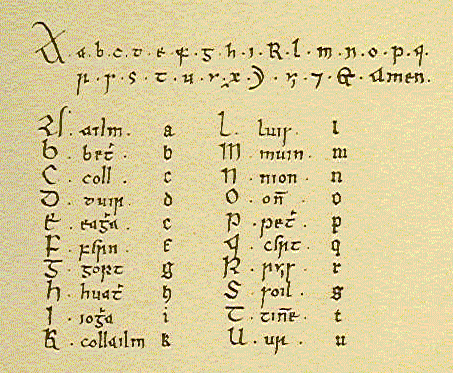The Irish Bible...
Republished
Achd fanuigh bríathar an Tíghearna go síorruidhe.
1 Pheadair 1:25
History of the Irish Bible

The Makings of the Irish Bible
It is well known that Saint Patrick (387-457 AD) preached to the people of Ireland in the language of ancient Gaelic from the Vetus Latina (Old Latin) Version of the Holy Bible. Ancient Irish (Gaelic) portions of the Psalms, a Gospel of St. Matthew, and other sacred writings have been found from as early as the seventh century, with much of the literature of that time filled with Scripture quotations. Portions of Scripture in the Irish language are even contained in sermons written down in the 8th – 11th centuries. A fourteenth-century Irish manuscript, the "Leabhar Braec" (the Speckled Book), published at Dublin (1872-5), contains a history of Israel and an extensive history of the New Testament. It also describes the Passion and the crucifixion of Jesus Christ. Another fourteenth-century manuscript, the "Leabhar Buide Lecain" (the Yellow Book of Lecan, written between c.1398 - 1417), also describes in Irish the Passion and contains a brief Old-Testament history. Many scholars see in all these writings indications of an early Gaelic version of the Scriptures previous to the time of St. Jerome in the 5th century A.D. demonstrating that the Bible was actively being copied and translated and spread throughout Europe even as far as Ireland on the northwestern shores of Europe.
The Irish New Testament of 1602/3 is known as William O'Donnell's Irish New Testament. His Irish name was O’Domhnuill.The original work began when Queen Elizabeth commissioned in 1571, at her ownexpense, the development of an Irish type font, and the purchaseof a press and all necessities for printing an Irish Bible for the Irish speaking people of Ireland. It is still known as the ‘QueenElizabeth’ Irish font type. She put two men in charge of the project: Nicholas Walsh, Chancellor of St. Patrick’s, Dublin, who then afterwards became Bishop of Ossory in 1577, and also John Kearney (or O’Cearnagh), the Treasurer of St. Patrick’s. Her hope was “that God in mercy would raise up some to translate the New Testament into their mother [Irish] tongue.” In the opinion of Father Edmund Hogan, Queen Elizabeth thereby “struck at the Irish language and literature a blow under which it has reeled for three centuries” (Irish Phrase Book p. 6).
About this time Elizabeth herself began to learn Irish, Lord Delvin having specially prepared a handwritten primer for her use, which still exists in the British Museum.
The work of translating from the authoritative Greek texts of the New Testament was begun in 1573. Along with these two men were William O'Donnell, from Kilkenny, who was Fellow of Trinity College, and Nehemiah (or Ferganainm) O’Donellan, a native of Galway (afterwards Archbishop of Tuam, 1595). Another helper in the work of translation was Máoilin óg Mac Brody, a man skilled in the Gaelic tongue in the new College by Dublin.
Their work took nearly 25 years to complete, and then five more years to set the type and put to print by John Francton the printer. This was no easy task. There were many obstacles and hardships that almost halted the translation work at every stage. Nicholas Walsh was murdered in his own house in 1585, while engaged in the work of translating. William O’Donnell wrote, ‘Under which burden how carefully and conscionably I have groaned, they onleely can judge, that can confer this translation with the original Greeke, unto which I have tyed my selfe, as of dutie I ought: having laboured therin in all sinceritie, as in the presence of God, the Judge of all to exprss the truly and fully, as neare as I could, without either detraction or addition, saving only in such places, where the necessitie of the phrase or sentece required it (as is usual in all translations, that cannot attiane unto the grace and proprietie of the originall) to give the full sense.’ (Tiomna Nuadh, n.p.; Cronin, op. cit. 1996, p.77).
William O'Donnell published the Irish New Testament as Tiomna nuadh ar dTigearna agus ar Slánaighteora (1602) – “The New Testament of our Lord and our Saviour (1602)”.
In the end, only 500 actual copies of the Irish New Testament were printed, but Sir Robert Boyle, who is best known as a scientist and as formulator of 'Boyle's Law', was deeply interested in publishing the Scriptures amongst the Irish, that he lived his later life determined to promote their circulation through several editions of the Irish New Testament primarily paid for by himself. Very few of those first editions have survived because they were “persecuted and speedily destroyed by the Popish priests of the day.” (https://en.wikipedia.org/wiki/Nicholas_Walsh_(bishop))